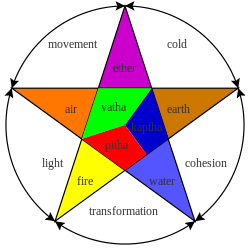Dosha
A dosha (Sanskrit: दोषः, doṣa) is one of three substances that are present in a person's body according to Ayurveda. Beginning with twentieth-century literature, there was an idea called "The Three-Dosha Theory" (Sanskrit: त्रिदोषोपदेशः, tridoṣa-upadeśaḥ). Authoritative Ayurvedic treatises describe how the quantity and quality of these three substances fluctuate in the body according to the seasons, time of day, diet, and several other factors. Ayurvedic doshas are markedly different from Latin humors.[1]

The central concept of Ayurvedic medicine is the theory that health exists when there is a balance between the three fundamental bodily bio-elements or doshas called Vata, Pitta, and Kapha.[2]
- Vāta or Vata is characterized by the properties of dry, cold, light, minute, and movement. All movement in the body is due to properties of vata. Pain is the characteristic feature of deranged vata. Some of the diseases connected to unbalanced vata are flatulence, gout, rheumatism, etc. [3][4] Vata is not to be interpreted as air.[1]
- Pitta represents metabolism;[1] It is characterized by heat, moistness, liquidity, and sharpness and sourness. Its chief quality is heat.[3] It is the energy principle which uses bile to direct digestion and enhance metabolism. Unbalanced pitta is primarily characterized by body heat or a burning sensation and redness.
- Kapha is the watery element. It is a combination of earth and water. It is characterized by heaviness, coldness, tenderness, softness, slowness, lubrication, and the carrier of nutrients. It is the nourishing element of the body. All soft organs are made by Kapha and it plays an important role in the perception of taste together with nourishment and lubrication.
So at last there are three primary doshit states: 1-Balanced - In this state all the three doshas are in equal proportion or are balanced. 2-Increased - In this state one particular dosha is in excess. 3-Decreased - It is also called deflected state as in this state one of the three following dosha is in very less or no presence.
| 5 types of vata dosha[5] | 5 types of pitta dosha[5] | 5 types of kapha dosha[5] |
|---|---|---|
|
|
|
Doshas are the forces that create the physical body. They determine conditions of growth, aging, health and disease. Typically, one of the three doshas predominates and determines one's constitution or mind-body type. By understanding individual habits, emotional responses, and body type, practitioners can adapt their yoga practice accordingly. The same applies for Ayurveda treatments focused on alleviating any doshic excesses (illness) via powerful herbs and/or through the improvement of general lifestyle practices such as pranayama, meditation and yoga postures.
There are clear indications when there exists an excess of a dosha, throwing the system off balance. For example, with excess vata, there can be mental, nervous and digestive disorders, including low energy and weakening of all body tissues. With excess pitta, there is toxic blood that gives rise to inflammation and infection. With excess kapha, there is an increase in mucus, weight, edema, and lung disease, etc. The key to managing all doshas is taking care of vata, as it is the origin of the other two.[6]
Notes and references
- Susruta; Bhishagratna, Kunja Lal (1907–1916). An English translation of the Sushruta samhita, based on original Sanskrit text. Edited and published by Kaviraj Kunja Lal Bhishagratna. With a full and comprehensive introduction, translation of different readings, notes, comparative views, an index, glossary and plates. Gerstein - University of Toronto. Calcutta.CS1 maint: date format (link)
- Hari Ghotra, Ayurveda - The Three Doshas
- Monier-Williams, Sanskrit-English Dictionary, Oxford, 1899
- http://www.ayurvedacollege.com/articles/drhalpern/Vata_Doshas Vata Dosha
- Govindaraj, Periyasamy; Nizamuddin, Sheikh; Sharath, Anugula; Jyothi, Vuskamalla; Rotti, Harish; Raval, Ritu; Nayak, Jayakrishna; Bhat, Balakrishna K.; Prasanna, B. V. (2015-10-29). "Genome-wide analysis correlates Ayurveda Prakriti". Scientific Reports. 5. doi:10.1038/srep15786. ISSN 2045-2322. PMC 4625161. PMID 26511157.
- David Frawley, Yoga and Ayurveda: Self-Healing and Self-Realization, 1999
